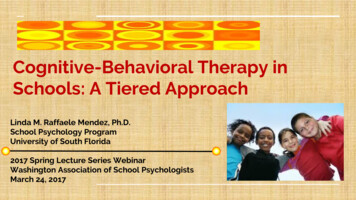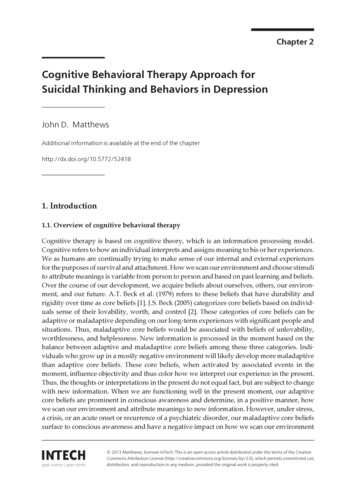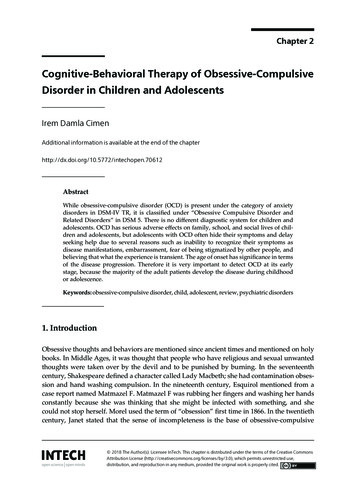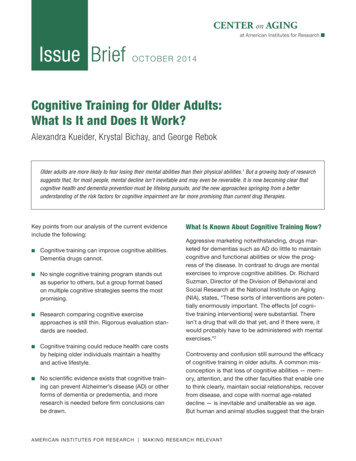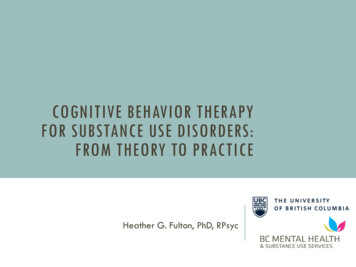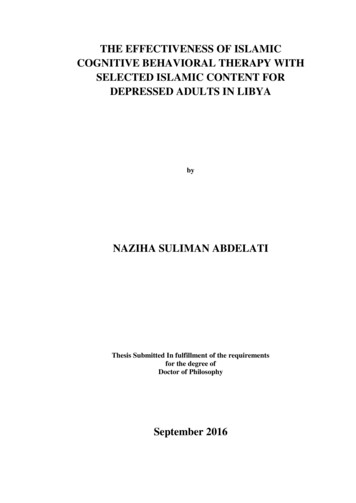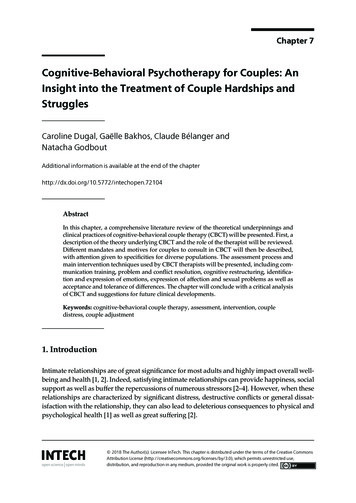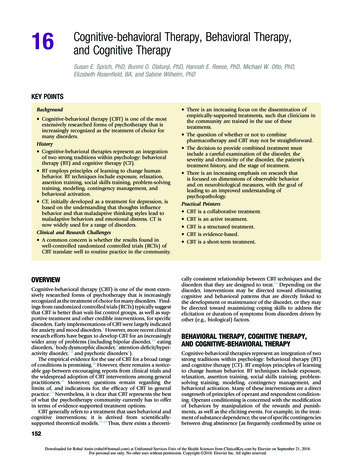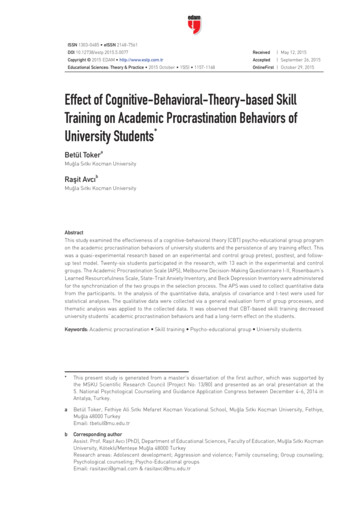
Transcription
ISSN 1303-0485 eISSN 2148-7561DOI 10.12738/estp.2015.5.0077Received May 12, 2015Copyright 2015 EDAM http://www.estp.com.trAccepted September 26, 2015Educational Sciences: Theory & Practice 2015 October 15(5) 1157-1168OnlineFirst October 29, 2015Effect of Cognitive-Behavioral-Theory-based SkillTraining on Academic Procrastination Behaviors ofUniversity Students*aBetül TokerMuğla Sıtkı Koçman UniversitybRaşit AvcıMuğla Sıtkı Koçman UniversityAbstractThis study examined the effectiveness of a cognitive-behavioral theory (CBT) psycho-educational group programon the academic procrastination behaviors of university students and the persistence of any training effect. Thiswas a quasi-experimental research based on an experimental and control group pretest, posttest, and followup test model. Twenty-six students participated in the research, with 13 each in the experimental and controlgroups. The Academic Procrastination Scale (APS), Melbourne Decision-Making Questionnaire I-II, Rosenbaum’sLearned Resourcefulness Scale, State-Trait Anxiety Inventory, and Beck Depression Inventory were administeredfor the synchronization of the two groups in the selection process. The APS was used to collect quantitative datafrom the participants. In the analysis of the quantitative data, analysis of covariance and t-test were used forstatistical analyses. The qualitative data were collected via a general evaluation form of group processes, andthematic analysis was applied to the collected data. It was observed that CBT-based skill training decreaseduniversity students’ academic procrastination behaviors and had a long-term effect on the students.Keywords: Academic procrastination Skill training Psycho-educational group University students*This present study is generated from a master’s dissertation of the first author, which was supported bythe MSKU Scientific Research Council (Project No: 13/80) and presented as an oral presentation at the5. National Psychological Counseling and Guidance Application Congress between December 4-6, 2014 inAntalya, Turkey.aBetül Toker, Fethiye Ali Sıtkı Mefaret Koçman Vocational School, Muğla Sıtkı Koçman University, Fethiye,Muğla 48000 TurkeyEmail: tbetul@mu.edu.trbCorresponding authorAssist. Prof. Raşit Avcı (PhD), Department of Educational Sciences, Faculty of Education, Muğla Sıtkı KoçmanUniversity, Kötekli/Menteşe Muğla 48000 TurkeyResearch areas: Adolescent development; Aggression and violence; Family counseling; Group counseling;Psychological counseling; Psycho-Educational groupsEmail: rasitavci@gmail.com & rasitavci@mu.edu.tr
Educational Sciences: Theory & PracticeWe have many occasions to say “later” in our lives,such as when paying bills, making appointments, ordoing homework. However, the longer we put offour tasks, the more they accumulate, the less theyare likely to be completed. Sometimes, tasks left forlater are entirely forgotten, but at times, they aredone at the last minute. This circumstance is definedas “procrastination” in the literature. Researchershave reached no consensus on definitions or types ofprocrastination, but it is a behavior that has existedsince the beginning of civilization (Steel, 2007) andis observed as one of the least understood humanproblems (Ferrari, 1994). Ferrari, Johnson, andMcCown (1995) state that just as procrastination,which is a complex problem, can be observedthroughout our lives in general, it can also arisespecifically in academic fields.Academic procrastination is defined as leavingacademic duties until later (Lay, 1986) and isobserved distinctly often in individuals whohave problems in academic subjects. Academicprocrastination includes consistently postponingstudying for exams, submitting assignmentslate, and failing to register for classes in time,and such behaviors ground the authenticity ofacademic procrastination as a concept (Tuckman,1991). Because of its authenticity, academicprocrastination has obtained more professionalinterest than other procrastination behaviors, andthere has been more scientific research on thesubject (Milgram, Marshevsky, & Sadeh, 1995).Research indicates that academic procrastinationis very common, particularly among universitystudents (Dewitte & Schouwenburg, 2002;Schraw, Wadkins, & Olafson, 2007). In Steel’sstudy (2007 as cited in Potts, 1987), approximately75% of university students view themselves asprocrastinators, and a study conducted in Turkeyfound academic procrastination behaviors among52% of university students (Uzun Özer, 2005).Furthermore, research reveals that the habits ofprocrastination can negatively affect students’academic positions, life quality, and performance(Lee, 2005), and these habits can also lead toguilt, decreased confidence, and stress, eventuallyresulting in numerous diseases (Tice & Baumeister,1997). In addition, there is a correlation betweenhigh levels of procrastination and low levels ofmental health (Stead, Shanahan, & Neufeld, 2010).Akbay and Gizir (2010) state that students whoengage in academic procrastination behaviorsexperience negative consequences such as failingcourses, extending periods of study, and terminating1158university educations. Gallagher, Golin, andKelleher (1992) state that 52% of students needto receive help with procrastination. The negativeconsequences of academic procrastination onacademic performance and emotional and physicalwell-being reveal the need for intervention studieson this topic (Glick, Millstein, & Orsillo, 2014).Studies stress the importance of developingcognitive, emotional/affective, and behavioral skillsto cope with academic procrastination behaviors(Çakıcı 2003; Knaus, 2010; Solomon & Rothblum,1984; Uzun Özer, 2010). Çakıcı (2003) addressesthe affective aspect of procrastination in the formof feeling personal distress about an individual’sinability to begin, sustain, or complete a task within aprescribed time. She refers to the behavioral aspect ofprocrastination as the tendency to delay beginning,sustaining, or completing a task, and she definesthe cognitive aspect of procrastination as a high orchronic disparity between an individual’s intentions,aims, or priorities and his/her task performance.Burka and Yuen (2008) state that many peoplewho exhibit procrastination behaviors in cognitive,emotional/affective, and behavioral dimensionsrepeat these behavior patterns at certain periods oftheir lives at different intervals and that this iterationis a procrastination loop. Knaus (2010) emphasizesthat the primary trigger of procrastination loops isindividuals’ ways of thinking.Cognitive-behavioral theory (CBT) states thatpeople procrastinate because of established ways ofthinking, and within this framework, CBT highlightsthe importance of replacing irrational beliefs withrational ones (Dryden, 2009). In this context, Beck(2005, p. 22) draws attention to core beliefs relatedto power, success, and performance and found that“despair” emerged as “I am inadequate, ineffective,incompetent; I can’t cope; I am inferior, a failure,a loser, not good enough etc.” Ferrari et al. (1995)listed five false cognitions: (i) overestimating theamount of time needed to complete a task, (ii)underestimating the required time, (iii) exaggeratingfuture incentives, (iv) developing false confidencethat a task will be initiated by providing affectiveconditions that are required to accomplish thetask, and (v) relying on ineffective or inappropriatecognitions to complete the task in the absence of thenecessary emotional sense.Research has emphasized that there are ination behaviors (Flett, Stainton, Hewitt,Sherry, & Lay, 2012; Knaus, 2010; Steel, 2007).For example, Flett et al. (2012) indicate that
Toker, Avcı / Effect of Cognitive-Behavioral-Theory-based Skill Training on Academic Procrastination Behaviors.negative automatic thoughts generally play animportant role in procrastination behaviors, andSteel (2007) reports in his meta-analysis study thatthere is a positive correlation between academicprocrastination and irrational thoughts. Balkıs(2013) and Balkıs, Duru, and Bulus (2013) statethat students with high levels of rational academicbeliefs demonstrate low levels of academicprocrastination; thus, they proposed a correlationbetween academic procrastination and cognitionsthat highlights the importance of changingcognitions in eliminating procrastination.Numerous experimental studies have focusedon the management of academic procrastination(Binder, 2000; Kutsela, 1998; Schubert, Lilly,Donald, & Stewart, 2000), and the lack of effectiveintervention programs is emphasized in theinternational literature (Rozental & Carlbring,2013; Rozental, Forsström, Nilsson, Rizzo, &Carlbring, 2014). Meanwhile, experimental studieson managing academic procrastination are newand quite limited in Turkey (Kağan, 2010; UzunÖzer, Demir, & Ferrari, 2013); in general, existingresearch focuses on organizing psycho-educationalprograms on the management of these behaviors,providing counseling, and highlighting the needto create and increase awareness through seminars(Balkıs & Duru, 2012; Kandemir, 2010; Özer &Altun, 2011; Uzun Özer, 2010).This research was an experimental study that aimedto investigate how to manage and overcome thewidespread academic procrastination observedamong university students, which remains vital aslong as it continues to have negative consequencesfor these students. Although this study is not thefirst either in Turkey or abroad, it is the distinctivepsycho-educational program developed by theresearcher using the cognitive-behavioral approach.Skills to manage procrastination behaviors canbe acquired in CBT-based programs. In the CBTcontext, practices in these groups aim to improvestudents’ basic skills at overcoming procrastinationand can be easily applied in the teaching–learningenvironment. Therefore, whether prepared grouppractices for eliminating academic procrastination,a particular problem in the education field, can leadto changes in university students’ procrastinationbehaviors can be investigated. Thus, this studyaimed to assess the effectiveness of a CBT-basedpsycho-educational program in altering universitystudents’ academic procrastination behaviors.MethodologyModel of the StudyThis study used a pretest–posttest, quasi-experimentalapproach with a matched-pair design (Büyüköztürk,Kılıç-Çakmak, Akgün, Karadeniz, & Demirel, 2008).The independent variable was a procrastinationpsycho-educational program, and the dependentvariable was academic procrastination.In the study, before the experimental applicationbegan, students were asked to complete a personalinformation form (PIF), Academic ProcrastinationScale (APS), Melbourne Decision-MakingQuestionnaire I-II (MDMQ I-II), Rosenbaum’sLearned Resourcefulness Scale (RLRS), State-TraitAnxiety Inventory (STAI), and Beck DepressionInventory (BDI). The students’ APS data wereconsidered pretest scores. The APS data were usedfor the posttest at the end of the experiment, andthe follow-up test was administered one monthafter the research ended. Qualitative data wereobtained only from the experimental group. Aftereight program sessions, the general evaluationform of group processes (GEFGP) was distributedto the students for evaluating the influence ofthe CBT-based skills training program on theirprocrastination behaviors.Study GroupThe study group in this research was 26 students(13 experimental and 13 control), who wereenrolled in the Faculty of Education, Faculty ofArts, Faculty of Economics and AdministrativeSciences, Faculty of Engineering, and Health HighSchool of University of Muğla Sıtkı Koçman duringthe academic year 2012–2013. Prior to the research,an ethics committee report was prepared, and anannouncement entitled “Coping Skills Trainingfor Academic Procrastination” was publishedon the university’s Website. This announcementincluded a voluntary informed consent formand a group policy form. In total, 70 universitystudents applied to participate in the study, butaccording to their PIF data, other measurementtools were administered to 63 students. On thebasis of these data, students who had alreadyreceived or were receiving psychiatric treatmentand who had a recent traumatic experience or highdepression scores were excluded from the study.In addition, 13 students were excluded because oftheir extreme APS scores (Tabachnick & Fidell,2001). In a previous study, it is stated that inexperimental studies, pairing participants based on1159
Educational Sciences: Theory & Practicecertain features allows for controlling independentvariables (Cohen, Manion, & Morrison, 2007); inthis study, the respondents were matched basedon variables that affected the dependent variable,academic procrastination (mean APS, BDI, STAI,MDMQ I-II, and RLRS scores), age, gender, andthe classes the students were enrolled in. In the nextstep, one respondent was randomly placed in theexperimental group and one was randomly placedin the control group; this method resulted in 15students in the experimental group and 15 in thecontrol group. After the sessions had started, twoparticipants could not continue and eventuallyleft their group. Because the experimental groupdecreased to 13 members, the control groupwas reduced to 13 by randomly excluding twomembers; thus, the study was eventually conductedwith 26 students. Both experimental and controlgroups consisted of 6 female and 7 male studentsaged 19–24 years; the mean ages of the students inthe experimental and control groups were 21.23and 21.07, respectively.Academic Procrastination Scale: The APS consistsof a total of 19 items, 12 positive and 7 negative,and it was developed to investigate academicprocrastination behaviors (Çakıcı, 2003). Itemsare rated on a 5-point Likert-type scale with “1 Itdoes not reflect me at all” and “5 It fully reflectsme.” A minimum of 19 points and a maximum95 points can be earned on the scale, with higherscores indicating more or greater procrastinationbehaviors. The APS is a two-factor scale with thefactors of procrastination and regular study habits.Because the first factor, procrastination, explained37.350% of the variance before the rotation and41.884% afterward, the scale can also be used onedimensionally. The Cronbach’s alpha coefficient ofinternal consistency for the one-dimensional scalewas calculated as .92, and the Spearman-Brownprediction split-test reliability was .85; test-retestreliability was .89 (Çakıcı, 2003). The APS was usedin this study as one-dimensional.PIF, APS, MDMQ I-II, RLRS, STAI, BDI, andGEFGP were used to collect the research data.Melbourne Decision-Making Questionnaire I-II:The original MDMQ was developed by Mann,Burnett, Radford, and Ford (1997) and was adaptedto Turkish by Deniz (2004). The scale consists of twoparts. The MDMQ-I aims to identify self-esteemin making decisions, and the MDMQ-II aims tomeasure decision-making styles (vigilance, buckpassing, procrastination, and hyper vigilance). Thetotal scale consists of 28 items, 6 on MDMQ-I and22 on MDMQ-II. Participants mark each statementon the scale as “not true,” “sometimes true,” or“true” using, respectively, ratings of 0, 1, or 2 points.High MDMQ-I scores indicate high self-esteem indecision making, and the MDMQ-II subscale scoresreflect respondents’ decision-making styles. Deniz(2004) examined the relationship between scoreson the Decision Strategies Scale and scores on theMDMQ-I and II for criterion validity and reportedpositive significant correlations that ranged from.15 to .71. In addition, test-retest reliability wasbetween .67 and .87, and Cronbach’s alpha rangedbetween .65 and .87 (Deniz, 2004).Personal Information Form: The PIF containedquestions on demographic information as well asindividual variables that could have affected theresearch findings (history of psychiatric treatment,history of or experience with trauma, experiencewith any group activities related to academicprocrastination) and factors that could have affectedstudents’ ability to participate in the entire program(academic, family, economic, employment, mentaland physical health, and disability status). Thisform was prepared by the researchers.Rosenbaum Learned Resourcefulness Scale:This original scale was designed by Rosenbaum(1980) and adapted to Turkish by Dağ (1991). Itevaluates how self-control skills and cognitivestrategies are used in stress situations. The scalehas 12 subscales and 36 items that are rated on a5-point Likert-type scale; the total possible scoreranges from 36 to 180 points, and higher scoresreflect a respondent’s greater self-control skills. Thescale’s test-retest reliability was found to be .80, andits coefficient of internal consistency is .78. Itemt-Tests were performed to calculate the significanceof any difference in the groups’ scores on the scalesthat were administered. According to the t-testresults, there was no significant difference in thegroups’ mean scores on the APS, BDI, STAI, RLRS,MDMQ I-self-esteem, MDMQ-II buck passing,MDMQ-II procrastination, MDMQ-II hypervigilance, or MDMQ-II vigilance subscales [t(24) .04, p .05; t(24) .04, p .05; t(24) .16, p .05;t(24) .36, p .05; t(24) .69, p .05; t(24) 1.42, p .05; t(24) 1.95, p .05; t(24) 1.74, p .05; t(24) .87, p .05, respectively]. Follow-up measurementswere obtained four weeks after the posttest to assesswhether the students’ gains from the experimentalintervention had been maintained.Data Collection Instruments1160
Toker, Avcı / Effect of Cognitive-Behavioral-Theory-based Skill Training on Academic Procrastination Behaviors.total correlations were calculated, with significantpositive correlations between .11 and .51. Criterionvalidity was calculated with the Rotter InternalExternal Control Scale, and a significant negativecorrelation of -.29 was found.State-Trait Anxiety Inventory: The STAI aimsto measure levels of state and trait anxiety inindividuals over 14 years of age. The scale wasdesigned by Spielberger, Gorsuch, and Lushene(1970) and adapted to Turkish by Öner and LeCompte (1985). It consists of two different scales(state and trait anxiety), and each scale has 20items; only the trait anxiety subscale was used inthis study. The trait anxiety subscale items arescored between 1 (almost never) and 4 (almostalways) for a minimum possible score of 20 pointsand a maximum of 80; higher scores indicate hightrait anxiety. On the Turkish form of the scale, theKuder-Richardson (alpha) reliability coefficientranged from .83 to .87. Total item reliability of thescale was determined to be between .34 and .85.Criterion validity and construct validity of the scalewere demonstrated at the expected levels.Beck Depression Inventory: The 21-item BDIself-assessment scale aims to measure symptomsof depression (Beck, Ward, Mendelson, Mock,& Erbaugh 1961). Items are ranked from 0 to 3according to the severity of each item. The scoresrange between 0 and 63, and higher scores indicategreater severity of depression. The Turkish versionof the BDI was adapted by Hisli (1989) in a studythat used university students, and the scale wasidentified as a reliable and valid instrument. Thesplit-test reliability coefficient of the scale was foundto be .74. The validity of the scale was determinedby criterion related validity methods and thecorrelation coefficient for the relationship betweenthe BDI and the Minnesota Multiphasic PersonalityInventory-Depression was found to be .50. Cut-offpoints for BDI depression scores were examined ina study by Hisli (1988) that used policlinic patients,and the author determined that scores of 17 orabove indicated higher than normal depression.General Evaluation Form of Group Processes:This form gathers feedback on group processesand benefits. It was designed by De Lucia-Waack(2006) and adapted to Turkish by Çolakkadıoğluand Güçray (2012). Six scale items are rated on a3-point Likert-type scale where 1 Yes, 2 No, and3 I do not know, and a maximum of 18 points ispossible; higher scores indicate less utility derivedfrom the group process. There are two open-endedquestions on which participants could discuss theirexperiences with the group process: questions 3 and5. In addition, questions 6, 7, and 8 were writtendown by the researcher.Experimental PraxisThe program that was used in this study was designedto improve the experimental group’s ability to managetheir academic procrastination and was based on CBT.Descriptive and experimental studies and suggestionsfrom the academic procrastination literature werereviewed during the process of developing the groupsession contents (Burka & Yuen, 2008; Knaus, 2010;Steel, 2007). Following this review, an appropriateframework was developed to ensure changes in coreand intermediate beliefs and automatic thoughts atthe cognitive level. Finally, group types, applications,objectives, and practices were all examined (Brown,2013; Delucia-Waack, 2006) and selected asappropriate. Beck (2001) outlined ten fundamentalprinciples of cognitive therapy, and these principlesguided the development of eight 90-minute groupeducation sessions; a general plan for the wholeprocess was prepared as well as specific plans for eachsession. The experimental program content focused onautomatic thoughts, intermediate thoughts related toacademic procrastination behavior, and core beliefs thatare formed during childhood. In addition, based onthe cognitive, affective, and behavioral dimensions ofacademic procrastination, problem-solving, cognitive,and behavioral techniques were used together. Thecontents of the sessions were supported by purposiveactivities, visual materials (cartoons, illustrations,diagrams, and so on), artistic objects (pictures, music,poetry, acrostics, and so on), metaphors, annotations,and homework and constructed with Socratic dialogueand other techniques. Each session began with asummary of the previous session (except for thefirst session) followed by discussing the homework,explaining the current session’s agenda, and warm-upactivities. The sessions ended with summarizing, givingfeedback and homework (except for the eighth session),and a closing activity.In addition, a pilot study was carried out before theexperimental program. The pilot study was conductedwith 16 first-year students who wanted to participatein the experimental program and who were enrolled inevening classes in the Muğla Sıtkı Koçman UniversityEducation Faculty Department of Educational SciencePsychological Counseling and Guidance Degreeduring the fall semester of the 2012–2013 academicyear. The pilot study was conducted with a leader, thefirst author of this paper, and a deputy leader who wasa leading expert in the field and who was pursuing1161
Educational Sciences: Theory & PracticePhD; the pilot study was recorded as well as supervisedand finalized by the second author of this paper. Basedon the pilot study, the sixth program session studiedthe core feeling of despair and the closing exercisesof the last session were modified; new activities wereincluded to improve member interactions.The general outlines of the sessions and briefinformation are provided below: To help students become familiar with the basiclogic of the CBT-based psycho-educationalprogram and determine their personal goals. To ensure that students were informed about thecognitive-behavioral approach. To assist students in recognizing their academicprocrastination behaviors and procrastinationloops as well as to help them to begin academictasks by understanding the relationship betweenthe action desire and continuity. To help students to increase their cognitiveawareness related to time and to gain the skillsto follow through with academic tasks they havealready begun. To help students gain awareness in terms offalse attributions of failure (“I failed”), academicself-esteem beliefs and outcomes, and processoriented and motivational perspectives. To help students develop self-confidence andmotivation for study behavior. To help students realize patterns of “ought to”related to their study behavior and to help themdevelop skills to change these patterns. To help students realize their habits that werepreventing permanent learning and to help themunderstand reasons for success rather than failure. To help students realize the strong possible longterm influence on the self-esteem of permanentlyavoiding unpleasant academic tasks. To help students realize their habits related toonly putting forth the effort to pass courses andto help them gain skills for permanent learning. To help students realize possible false automaticthoughts that can occur during examinations orother activities and to develop and implementalternative thoughts. To help students develop skills for breathing,relaxation, and safe place techniques in cases ofextreme stress.1162 To help students realize the extent to which theyhave attained their initial personal goals and tohelp them share gains derived from their groupexperiences.Data AnalysisPretest, posttest, and permanency APS datawere collected from both the experimental andcontrol groups to test the research hypotheses andwere analyzed using the analysis of covariance(ANCOVA) feature in SPSS 17; specifically, thet-test was used for repeated measures and forindependent groups, and the normality of the datawas investigated. Normality assumptions wereexamined using the Shapiro–Wilk test, and thegroups’ pretest, posttest, and permanency scoreswere determined to be normally distributed (p .05). Homogeneity of variances was examined usingLevene’s test for both the experimental and controldata. Furthermore, the t-test was used to investigatewhether there were significant differences betweenboth groups with respect to the control variables.Qualitative data for the research were obtainedfrom the experimental group using the GEFGP, andthe data were analyzed by the thematic approach(Yıldırım & Şimşek, 2011).FindingsAcademic Procrastination Scale FindingsIt was identified that variances were homogeneousfor the experimental and control groups (p .05).In addition, the existence of a linear relationshipbetween the control and dependent variables wasexamined with the Pearson product-momentcorrelation coefficient, and a linear relationship wasdetermined. Analysis of variance was used to testregression trend lines for the APS posttest scores ofboth groups, and the results indicated no significanteffect of group pretest [F(1–22) 17.739; p .05];thus, equal regression trend lines were determined.The t-test results for the retest measurements andindependent groups were used for the data that didnot satisfy the ANCOVA assumptions. APS meanscores, standard deviations, and adjusted posttestscores are presented in Table 1.Means and standard divisions of the experimentaland control groups for the APS pretest, posttest,and follow-up scores are given in Table 1. For theexperimental group, the pretest mean was 62.69(Ss 11.99), posttest adjusted mean was 47.23,and follow-up mean was 44.09 (Ss 9.12). On the
Toker, Avcı / Effect of Cognitive-Behavioral-Theory-based Skill Training on Academic Procrastination Behaviors.Table 1Descriptive Findings for the APS Pretest, Posttest, and Follow-up ScoresMeasurementPretestPosttestFollow-up testPosttest AdjustedMean 8.9212.61other hand, for the control group, the pretest meanwas 62.46 (Ss 12.47), posttest adjusted mean was60.00, and follow-up test mean was 58.92 (Ss 12.61). The table shows that the posttest adjustedmean and follow-up mean for the experimentalgroup were lower than those for the control group.First, ANCOVA was used to determine whetherthese differences were significant, and the findingsare given in Table 2.Table 2ANCOVA Results for Academic Procrastination Scale forPosttest Adjusted Mean Scores by GroupThe Source ofthe VarianceSum 03.782Total5172.15425*p .01.According to the results presented in Table 2,a statistically significant difference was foundbetween the posttest adjusted means in favor ofthe control group [F(1–23) 10.223; p .01]. Thatis, the experimental group’s adjusted academicprocrastination mean declined as a result of thegroup’s participation in the psycho-educationalprogram. There was no significant difference betweenthe posttest and follow-up test means [t (12) 1.26, p .05], but there was a significant difference betweenthe follow-up test means for the experimental groupvs. control group [t(24) 3.439, p .01]. Specifically,the experimental group’s follow-up test mean waslower when compared with the control group, andthus, it can be said that the effectiveness of theexperimental program was lasting.Findings of the General Evaluation Form ofGroup ProcessesThe responses to the GEFGP’s close-endedquestions 3 and 5 are shown in Table 3.xdTable 3Experimental Group Responses to GEFGP Questions 3 and 5QuestionsYes No3. This training guided me in my ability to gain skills to manage academicprocrastination behavior.135. I will suggest my friends to participate in an academic procrastinationpsycho-educational group.13I do notknowAs shown in Table 3, all participants reportedbenefiting from the psycho-educational groupexperience by gaining skills to better manage theiracademic procrastination behaviors. In addition, allmembers of the experimental group would suggesttheir friends to participate in similar psychoeducational groups or programs. In the overallframework, all experimental group members feltpositive about the group practices, were satisfiedwith the group processes, and would recommendtheir friends to participate in similar programs.The experimental group’s responses to GEFGPopen-ended questions
DOI 10.12738/estp.2015.5.0077 . on the academic procrastination behaviors of university students and the persistence of any training effect. This was a quasi-experimental research based on an experimental and control group pretest, posttest, and follow- . negative automatic thoughts generally play an important role in procrastination .
